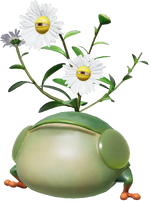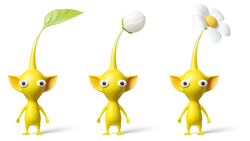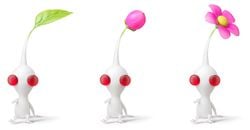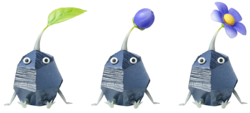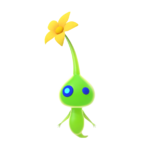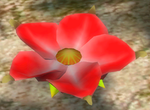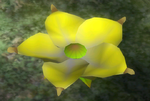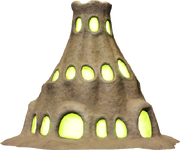User:Super-mario/Ambuloradicis class
Not an article just for fun.
The ambuloradicis family is a class of plant-animal hybrids in all Pikmin games. Many of their members are parasitic namely Creeping Chrysanthemum, Startle Spore, Rock Pikmin and Bulbmin.
Members
Onionshell
- Main article: Onionshell family.
The Aristocrab Offspring is confirmed to be a member of the ambuloradicis family thus presumably all members of their family are.[1]
|
Warning: the following text contains major spoilers about Onionshell species.
|
|---|
Peckish Aristocrab
The Peckish Aristocrab is an enemy found in Pikmin 3 and Pikmin 4. It uses its large pincer to block incoming Pikmin throws, as well as to snatch Pikmin up to eat. Since the pincer is made of crystal, it can be broken by Rock Pikmin. Once disarmed, the creature resorts to evading Pikmin attacks and blowing bubbles to keep them away. Aristocrab Offspring
A juvenile Peckish Aristocrab, the Aristocrab Offspring is not able to block Pikmin throws with its pincer but can still blow bubbles to keep Pikmin away. It may occasionally hide under the sand, leaving only its eyes visible. |
Chrysanthemum
- Main article: Chrysanthemum family.
The Startle Spore is confirmed to be a member of the ambuloradicis family thus presumably all members of their family are.[2]
|
Warning: the following text contains major spoilers about Chrysanthemum species.
|
|---|
Creeping Chrysanthemum
Scientific name: Taraxacum rovinia The Creeping Chrysanthemum is a carnivorous member of the Chrysanthemum family. In Pikmin 2 it is a large plant-like creature with a red mouth, two eyes on its shoulders disguised as flowers, and two arm-like tentacles that it uses to move around; in Pikmin 4 it has a more froglike body and legs as well as a long tongue that it uses to catch prey. This creature disguises itself as a Margaret, rising up out of the ground and attacking prey that ventures near; as such, they are often found near real Margarets. It can be distinguished from a Margaret because its eyes are visible when camouflaged. Margaret
Scientific name: Luminosus croeaus Margarets are yellow, dandelion-like plants. They tend to grow in bright places, such as the Awakening Wood. Creeping Chrysanthemums are often found where there are many of these plants. Unlike other species, these do not have any apparent animalist features. Startle Spore
Scientific name: Taraxacum fungenesus The Startle Spore disguises itself as a cluster of mushrooms rather than as a plant, and leaves behind pools of poisonous liquid when it attacks. |
Pikmin
- Main article: Pikmin family.
The Pikmin are confirmed to be members of the ambuloradicis family.[3]
|
Warning: the following text contains major spoilers about Pikmin species.
|
|---|
Red Pikmin
Scientific name: Pikminidae rubrus Red Pikmin have pointy noses and white flowers, and are present in all Pikmin games. They are resistant to fire and have a stronger attack strength than other types, making them good at combat dealing 1.5x damage more then other Pikmin types. They are the first type discovered in all Pikmin games (Although Yellow Pikmin are the first type seen in Pikmin 3, the Red Pikmin are the first to be properly introduced). Yellow Pikmin
Scientific name: Pikminidae auribus Yellow Pikmin have large ears and white flowers, and are present in all Pikmin games. They can be thrown higher than other types, but their other unique abilities vary by game. In Pikmin, they are the only type that can carry bomb rocks. In Pikmin 2, Pikmin 3, Pikmin 4 and Hey! Pikmin, they are resistant to electricity (they can also conduct electricity in Pikmin 3 and Hey! Pikmin). In Pikmin 3 and Pikmin 4, they can dig faster than most other Pikmin types. Additionally, in Pikmin 3, they are the first type to be seen, although they are only used for a short tutorial. Blue Pikmin
Scientific name: Pikminidae caerula Blue Pikmin have mouthlike gills and white flowers, and are present in all Pikmin games. They are resistant to water, making them the only type able to access submerged portions of areas where other Pikmin would drown. They are the last type discovered in most games with a linear discovery order, the exceptions being Hey! Pikmin, Pikmin Bloom and Pikmin 4. Purple Pikmin
Scientific name: Pikminidae yokozunum Purple Pikmin have short hairs, pink flowers, and are bulkier than other Pikmin types. They are present in Pikmin 2, Pikmin 4 and Pikmin Bloom, as well as the alternative game modes of Pikmin 3. They weigh 10 times as much as other Pikmin types, are slower than other types, can carry 10 times the weight of other types, and can attack with a strong pound capable of stunning enemies. In all games except Pikmin 4, they do not have an Onion, and must be gained by using Candypop Buds. White Pikmin
Scientific name: Pikminidae venalbius White Pikmin have red eyes, pink flowers, and small, thin bodies. They are present in Pikmin 2, Pikmin 4 and Pikmin Bloom, as well as the alternative game modes of Pikmin 3. They are resistant to poison, are faster than other Pikmin types, can poison enemies upon being eaten, and in Pikmin 2 can dig out treasures completely buried in the ground that other types cannot see. In all games except Pikmin 4, they do not have an Onion, and must be gained by using Candypop Buds. Rock Pikmin
Scientific name: Pikminidae habisaxum Rock Pikmin are parasitic Pikmin inhabiting rocks and have purple flowers. They are present in Pikmin 3, Pikmin 4, Hey! Pikmin, and Pikmin Bloom. Their hardness allows them to destroy crystal obstacles, attack enemies through a powerful direct impact, and be resistant to being crushed or stabbed. Winged Pikmin
Scientific name: Pikminidae volarosa Winged Pikmin are pink and have wings, large blue eyes, and purple flowers. They are present in Pikmin 3, Pikmin 4, Hey! Pikmin, and Pikmin Bloom. They can fly over water and low barriers, allowing them to take shortcuts when carrying, as well as making it harder for enemies to attack them, but their attack strength is lower than other Pikmin types. Ice Pikmin
Scientific name: Pikminidae habiglacius Ice Pikmin are cyan with icy bodies similar to Rock Pikmin, albeit with a distinct head, and yellow flowers. They are only present in Pikmin 4. Ice Pikmin are immune to being frozen and can freeze enemies by filling up a meter around the enemy's health wheel by attacking or by being eaten. The bodies of frozen enemies shatter upon death, leaving a droplet of nectar behind in a manner similar to how ultra-bitter spray functions. They can also be tossed into water to freeze it, freezing any enemies and treasure inside until the water unfreezes, and allowing leaders and other Pikmin to walk across its surface. Glow Pikmin
Scientific name: Pikminidae supravelum Official family unknown Glow Pikmin are a special species of Pikmin with green bioluminescent ghost-like bodies and yellow star-like flowers, and are present in Pikmin 4 only. They are resistant to every elemental hazard, as well as not slowing in mud, being unable to be controlled, not being able to be buried, and warping back to safe ground if they fall into an abyss. They will teleport to the active leader if they are not fighting or working on a task. They are the only type available in night expeditions, and can be summoned inside caves with Glow Seeds. They are also able to perform a group attack known as a Glowmob, which stuns enemies it hits. Additionally, they have no Onion or Candypop Bud color, and are propagated by bringing Glow Pellets to a Lumiknoll. Bulbmin
Scientific name: Parasiticus pikminicus Bulbmin are a special species of Pikmin shaped like a minuscule Bulborb with a stem, white flowers, and are present in Pikmin 2 only. They are always found following a larger Bulbmin which must be defeated to be able to command them. They are resistant to fire, water, electricity, and poison, but cannot be taken out of caves, which are the only places they are found in. They are actually a parasite that takes over a juvenile Bulborb; the appearance of the parasite on its own is not known. |
Presumed members
Pellet weed
- Main article: Pellet weed family.
The Pellet Posy is said to be related to the pikmin and candypop families.[4]
|
Warning: the following text contains major spoilers about Pellet weed species.
|
|---|
Pellet Posy
Scientific name: Amplus nutrio Pellet Posies are important plants in the Pikmin games. They hold a pellet, which can be retrieved after Pikmin attack the plant. The pellet they hold can be of any color of the currently discovered Pikmin types, or it can cycle through the available ones in short intervals. Pellet Posies bearing 1-pellets, 5-pellets, 10-pellets, and 20-pellets exist. After one is destroyed, a stub will grow the next day, and after some in-game hours, it will grow to become a new Pellet Posy. Burgeoning Spiderwort
Scientific name: Pikflora baccae conditus Burgeoning Spiderworts are plants that make their first appearance in Pikmin 2. These flowers hold ultra-spicy berries (or ultra-bitter berries—or sometimes both—in Pikmin 2), and will drop them if attacked by Pikmin. Dropped berries can be brought back to the player's ship, which will convert ten of them them into ultra-spicy or Ultra-bitter spray. The Spiderwort will regenerate its berries after a while. |
Candypop
- Main article: Candypop family.
The Candypop Bud is even speculated to be the "next step in Pikmin evolution".[5]
|
Warning: the following text contains major spoilers about Candypop.
|
|---|
Candypop Bud
Scientific name: Flora expellus When Pikmin are tossed into a Candypop Bud, Pikmin of the same color are shot back out, allowing Pikmin to be converted between types. There are 8 colors of Candypop Bud, each corresponding to a type of Pikmin. (In Pikmin 2, different colors of Candypop Buds are considered different species, while in Pikmin, Pikmin 3 and Pikmin 4, all colors are considered the same species.) Crimson Candypop Bud
Scientific name: Flora rufusia Crimson Candypop Buds produce Red Pikmin seeds. This name is only used in Pikmin 2. Flarlic
Scientific name: Bulbus lillium A Flarlic resembles a colorless Onion. If carried to the Onion, 10 more Pikmin will be allowed out in the field, unless the limit of 100 has already been reached. Golden Candypop Bud
Scientific name: Flora aurumia Golden Candypop Buds produce Yellow Pikmin seeds. This name is only used in Pikmin 2. Ivory Candypop Bud
Scientific name: Flora niveus Ivory Candypop Buds produce White Pikmin seeds. This name is only used in Pikmin 2, where this species is the only way of obtaining White Pikmin. Lapis Lazuli Candypop Bud
Scientific name: Flora cobaltium Lapis Lazuli Candypop Buds produce Blue Pikmin seeds. This name is only used in Pikmin 2. Onion
Scientific name: Lillium pikminporta Onions are large and round life forms that act as nests for the Pikmin. They allow leaders to store and retrieve Pikmin, as well as spitting out new Pikmin seeds. Additionally, starting in Pikmin 3, Onions of different types are capable of merging together. Queen Candypop Bud
Scientific name: Flora regina Queen Candypop Buds are unique in the Candypop family. Their petals are white with colored spots which cycle between red, yellow, and blue. When a Pikmin of any type is tossed in, 9 seeds which match the color of the spots are ejected, giving players an eight-Pikmin gain. After the seeds are ejected, the Queen Candypop Bud wilts. These flowers are generally found in rest sublevels of caves, to let the player increase their Pikmin population. They only appear in Pikmin 2. Violet Candypop Bud
Scientific name: Flora puniceus Violet Candypop Buds produce Purple Pikmin seeds. This name is only used in Pikmin 2, where this species is the only way of obtaining Purple Pikmin.
|
Lumiknoll
- Main article: Lumiknoll.
Scientific name: Collux aeternium
Lumiknolls are large dirt mound nests found in night expeditions in Pikmin 4. They are the home to Glow Pikmin, and function similarly to the Onion, although their behavior is quite different. Lumiknolls produce Glow Pikmin when fed with glow pellets. Juvenile Lumiknolls, known as Tricknolls, are also found within night expeditions and serve as an extension of the Lumiknoll.
They are speculated to be rhizomes of Onions.[6]
Naming
It comes from the Latin ambulacrum, meaning "to walk", and radicula which means "radish" or "root vegetable". Ambuloradices could be translated as "walking root" or "walking radish" (reddit)
Names in other languages
| Language | Name | Meaning |
|---|---|---|
| Ambuloradicis |
See also
- Dandelion family, shares genus with Chrysanthemum members and similar to Margarets
- Hydroe family, parasites
- Sporovid family, parasites and mushroom-animal hybrids known as Ambulofungus
- Mireclops family, parasites, plant-animal hybrids and similar to Creeping Chrysanthemum in Pikmin 2
References
- ^ “Perhaps it's a close relative of species in the Ambuloradicis class.” – Olimar in Olimar's notes
- ^ “As a result, we can theorize that like fellow Ambuloradicis the Bulbmin, this species is not an evolutionary variation, but that the body is a parasite that has nestled inside a group of mushrooms.” – Olimar in Olimar's notes
- ^ “Pikmin are a part of the Ambuloradicis class, which consists of creatures that exhibit both plant and animal characteristics.” – Olimar in Olimar's notes
- ^ “In the stem of the pellet posy, one can observe the muscle fiber unique to half-plant, half-animal species such as the Pikmin and candypop flowers, so the pellet posy is a species that can be considered a close relative.” – Olimar in Olimar's notes
- ^ “Could this be the next step in Pikmin evolution? Like the Pikmin themselves, it has many mysteries.” – in Enemy reel
- ^ “Lumiknolls will only appear in places where an Onion was located earlier in the day, and since they propagate Glow Pikmin, one could surmise that they are rhizomes from those Onions.” – Olimar in Olimar's notes

